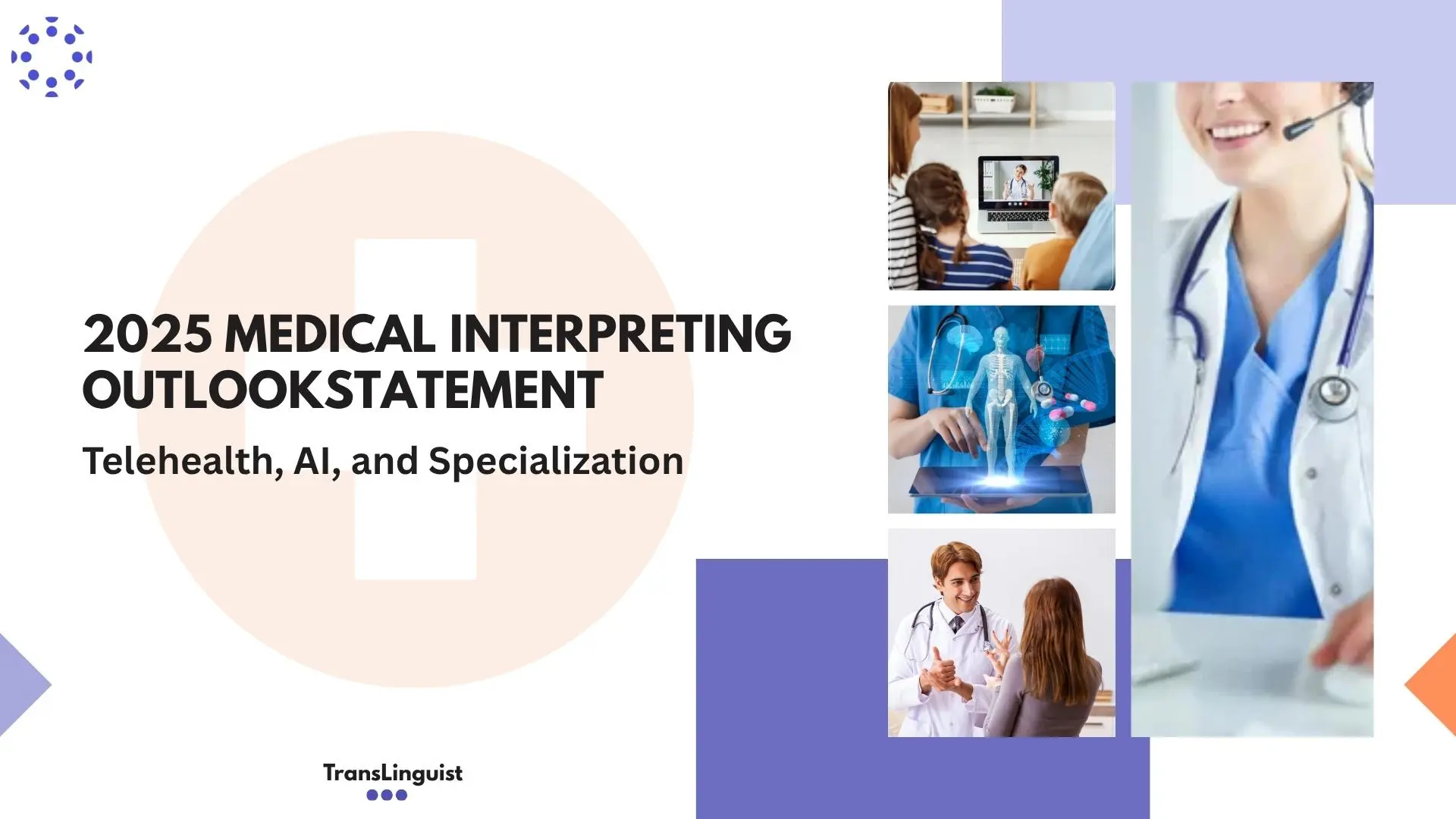Health systems are under pressure to do more with less, and Medical Interpreting is central to safe care, not a “nice to have.” In 2025, leaders are baking Medical Interpreting into clinical quality, compliance, and patient-experience plans instead of treating it as an ad-hoc call-in. New research highlights workflow integrations, outcome tracking, and blended human-plus-technology support, reshaping Medical Interpreting in telehealth, EDs, and routine visits.
From on-demand to fully integrated care workflows
The biggest shift is operational: hospitals want interpreting to appear exactly where clinicians already work inside EHRs, call platforms, and virtual care tools so staff don’t toggle between systems or skip language access under time pressure. Reports on 2025 priorities highlight growing demand for integrations that reduce clicks and make routing to the right interpreter automatic at the point of care.
What to do now:
Map your top five patient journeys (ED triage, telehealth intake, inpatient rounds, discharge, billing disputes) and ensure an interpreter can be summoned from the screen staff already use, with the encounter logged to the patient record for audits.
Compliance is tightening; “meaningful access” isn’t optional
For U.S. providers receiving federal funds, Title VI and health-sector civil-rights guidance require “reasonable steps” to ensure meaningful access for people with limited English proficiency (LEP). In practice, that means qualified interpreters, translated vital documents, and language access plans supported by monitoring. Expect renewed oversight in 2025 as agencies update and clarify obligations.
Action check:
Confirm your language access plan, bilingual signage, and interpreter qualifications are documented; verify that discharge instructions and consent forms are available in the patient’s language where required.
Human interpreters stay at the center even as AI expands
Tools that automate transcripts or provide assistive prompts are improving, but clinical conversations still need human judgment, register control, and cultural mediation especially during sensitive consent, mental-health, pediatrics, and end-of-life discussions. 2025 technology round-ups emphasize AI as an assist, not a replacement: expect AI to help with after-visit summaries, context prompts, or quality review, but a trained interpreter carries the interaction.
Practical blend:
Use human interpreters for live clinical encounters; use AI to produce draft notes or searchable transcripts that a clinician or compliance reviewer can verify.
Privacy, security, and audit trails move to the front
As more interpreting goes remote or hybrid, leaders are hardening privacy controls: secure connections, least-privilege access, encounter logging, and data-retention policies suitable for HIPAA/PHI. Industry commentary points to stricter expectations in 2025 across healthcare for protected workflows and vendor attestations.
What to verify:
BAAs where applicable, encryption in transit, interpreter authentication, and whether your vendor logs language, duration, and mode by MRN to support audits.
Staffing models diversify to cover peaks and specialties
Organizations are blending on-site, video, and phone coverage; creating pools for high-acuity departments; and tagging interpreters by specialty (oncology, maternal health, behavioral health). Telehealth growth continues to make video the default for non-emergent visits, while in-person is prioritized for complex or vulnerable encounters. Peer-reviewed studies during and after the pandemic underline that remote options reduced delays but couldn’t replace every use case.
Tip: Build a tiered coverage plan video for general care, on-site for critical consults and complex disclosures, and phone as the quick bridge for brief updates.
Program quality is tied to training and credentials
Hospitals increasingly insist on documented training for anyone interpreting in clinical settings. In the U.S., national bodies commonly cited by compliance teams expect at least 40 hours of healthcare interpreter training before certification pathways and exams. Standardizing credentials simplifies privilege and signals reliability to clinicians.
Quick win:
Audit interpreter rosters against the 40-hour training baseline and capture proof of continuing education for re-credentialing cycles.
Measurement, not anecdotes: closing the data loop
Leaders want to see whether language access actually improves outcomes completion rates, readmissions, medication errors, no-show reductions, and CAHPS/ED CAHPS deltas for LEP cohorts. Recent surveys note that many systems still don’t track LEP outcomes as a distinct group; 2025 priorities call for fixing that gap with simple tags and dashboards.
Start simple:
Add an LEP flag in the EHR, require encounter logging when an interpreter is present, and compare key metrics between LEP and non-LEP patients quarterly.
How TransLinguist can help: Tied to the Trends above
- Remote & On-Site Interpreting: Tiered coverage (video, phone, on-site) matched to clinical scenarios, with pre-briefs for complex consults.
- Speech AI & Live Captions: Assistive transcripts and searchable notes for quality review used alongside human interpreters, not in place of them.
- Translation & Vital Documents: Patient-facing forms, discharge instructions, and after-visit summaries aligned to your language-access plan.
- Program Design & QA: Build EHR/workflow integrations, set credential standards, and create dashboards that show outcomes not just volumes.
Conclusion
The organizations that win in 2025 treat Medical Interpreting as infrastructure. They integrate services into clinical systems, train to recognized standards, and track outcomes instead of anecdotes. Do that, and Medical Interpreting becomes a clear driver of safety, compliance, and patient trust. If you need a partner to stand up a measurable program without derailing ops, TransLinguist can help design, staff, and optimize the language-access layer your clinicians need.
Ready to make language access measurable and defensible? Talk to TransLinguist about a right-sized plan for Medical Interpreting from triage to telehealth to discharge.
FAQs
Do we have to provide interpreters for every visit?
Civil-rights guidance requires “reasonable steps” for meaningful access to programs and activities; high-risk or federally funded services typically expect qualified interpreters when language is a barrier. Document your policy and when you escalate to live support.
Where should we use on-site vs. video vs. phone?
Use on-site for complex disclosures and high-acuity care; video for routine and telehealth; phone for quick updates or low-bandwidth scenarios—then confirm in your policy and staff playbooks.
How do we measure impact?
Tag LEP patients in the EHR, log interpreter encounters, and track readmissions, medication errors, and satisfaction deltas. Recent industry surveys show many systems are adding LEP-specific metrics in 2025.
What about data security for remote sessions?
Require encrypted connections, BAAs as applicable, authenticated log-ins for interpreters, and encounter logs to support audits and HIPAA compliance practices.



